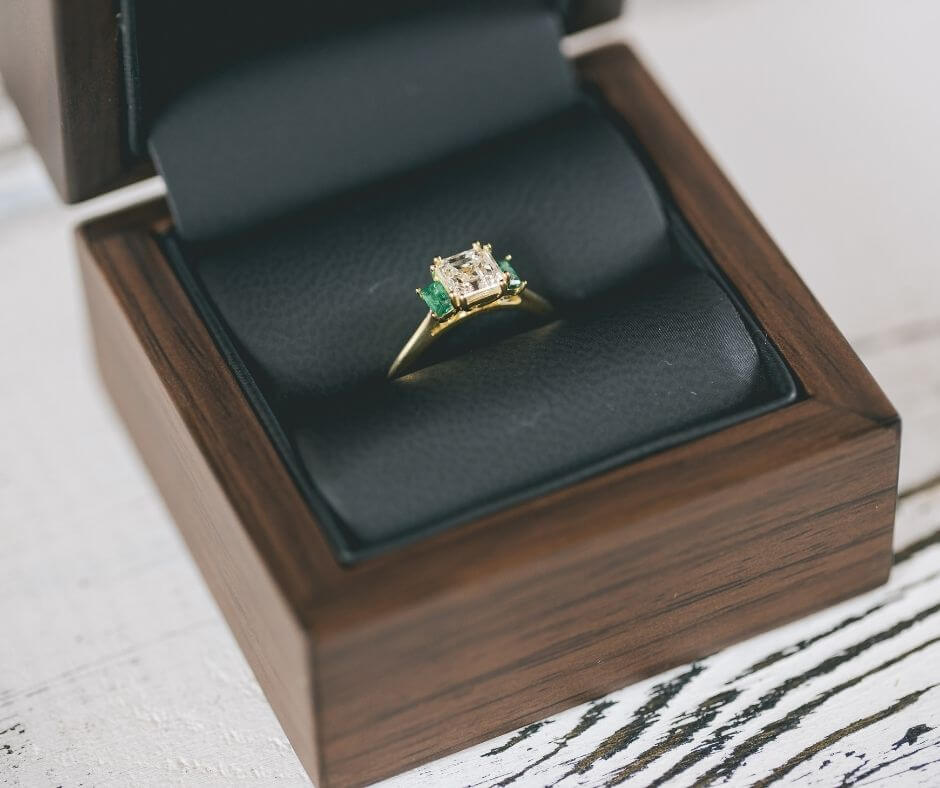By Sophia Young, guest writer
Diamonds are gorgeous gems. Their ability to reflect light and bring an intense sparkle to any piece of jewellery makes them incredibly attractive to brides. As diamonds are the most popular stone of choice for engagement rings, it is important to understand the best cut and shape that fits your style and preference.
Cut vs Shape
It’s quite easy to mistake cut and shape for one another, and many newbies to jewellery will confuse the two.
To make it simple, the cut refers to how the facets of a diamond are arranged. This includes the symmetry, dimensions, and reflective quality that is brought out with each different style of cut. Certificated diamonds are judged and graded on how well cut they are, so how well they reflect light between the facets.
A diamond shape refers to the outline of the diamond when it’s faced upward. Some classic outlines include rounds, ovals, hearts, and squares. Confusing as it sounds, it is important to understand that both the quality of the cut and shape work in tandem to create the overall brilliance of the diamond you choose for your engagement ring.
Here are the top eight diamond shapes for engagement rings to inspire your own unique ring:
Round Brilliant Cut Diamonds
First and foremost we start with the classic and most popular of all diamond choices: a round brilliant cut. This shape and cut are undeniably the most chosen for engagement rings. Many brides-to-be chose a round shape diamond for their primary stone. The shape of this particular choice of diamond maximises the fire or the intensity of the stones’ sparkle.
Although, it is important to keep in mind that round diamonds are sold at a higher price-per-carat compared to other shapes and cuts.

Princess Cut Diamonds
In second place are Princess-cut Diamonds. These diamonds are brilliant cut diamonds in a square shape. This cut is shown to have a unique quality as there is no standard number of facets to each stone. Furthermore, the flat sides of a princess cut give lots of options for accompanying side stones.
Another plus to this type of cut is that it retains more surface area than a diamond when creating a Princess and typically costs less compared to round diamonds.

Emerald Cut Diamonds
Another popular cut is the emerald cut diamonds. These diamonds are made with step-cuts which consist of rectangular facets on the sides of the stone. Emerald cut diamonds show a marked elegance on their own as it easily showcases the colour and quality of each diamond.
If you prefer your ring to have an elegant centre gleam, this is the cut for you.

Cushion Cut Diamonds
Cushion-cut diamonds are a favorite for vintage jewelry enthusiasts. This magnificent cut is often compared to a pillow, with smooth, rounded corners and a square-cut combination. A well-cut cushion diamond disperses light extremely well resulting in a stone with more sparkle.
However, a common piece of jewellery care advice suggests choosing an H colour diamond or above when choosing a cushion cut. That’s because this specific cut retains more of the colour of the stone.

Asscher Cut Diamonds
Clean and glamorous, asscher-cut diamonds are square emerald cuts with ever so slightly blunted corners. These cuts have geometrically arranged with step-cut facets that create a bold and more modern look compared to cushion-cut diamonds. They scream Art Deco glamour.

Marquise Cut Diamonds
Marquise-cut diamonds are perfect for those who are looking for a diamond that makes a bold statement. Compared to other cuts, marquise-cut diamonds look larger than their actual carat weight. With curved sides and pointed edges, marquise cuts are also called “little boats” from their shape.
This cut creates a regal feel as it can stand alone on a ring band and can make the wearer’s finger longer and more graceful.

Oval Brilliant Diamonds
Like Marquises, oval diamonds offer a stone with a visually impressive size. Since these cuts belong to the round brilliant family of cuts they feature a similar faceting pattern, which maximises their sparkle and fire. The elongated shape of oval diamonds can create the illusion of longer and slimmer fingers.
Nowadays, oval-brilliant cuts are seen worn by celebrities helped boost their popularity.

Pear Diamonds
Pear-shaped diamonds are also called teardrops, taking their style from the marquise and oval cuts. This shape shows a curved edge on one side and a pointed one on the other. This style tends to appear larger but also compliments the length of the finger which makes it perfect for those wanting to wear a bigger stone.
Since one side of this shape is pointed, always remember to find a ring with an appropriate setting as to prevent the stone from chipping.

The Choice is Yours
In the end, the choice of diamond cut and shape for an engagement ring is a deeply personal one, influenced by individual style and preference. By understanding the nuances and characteristics of each cut, you can make an informed decision to find the perfect diamond that will forever symbolise your love and commitment.
Written by guest writer Sophia Young

